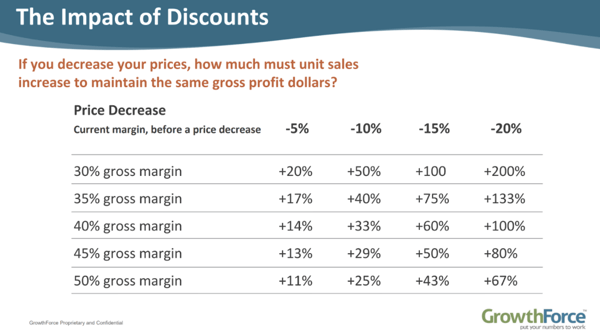5 min read
.jpeg?width=600&height=400&name=AdobeStock_567028112%20(1).jpeg)
The single most important decision a business owner will make is pricing: how do I price my products or services?
|
Key Takeaways
|
Discounts do more to destroy your profits than anything else.
As a business owner, it is not uncommon to have a sales representative come to you and say, "It's a competitive deal. We need to give a discount of 10% and we'll close this."
Here is why giving a discount is not always the answer, and could do more harm to your business than good...
Your Profit Margin Takes a Hit When Discounts Are Involved
Sales will have to work a lot harder to make up for every discount
Your margins are higher when selling a product or service at full price, compared to selling at a discount. The profit margin you lose through discounting will still have to be made up with future opportunities, so you’ll have to sell more to get back the revenue lost.
For example, if you have a 30% margin, and you give a 10% discount, you have to sell 50% more business to make the same profits.

Use this impact of discount calculator to see how discounts will affect your profit margins, and how much (in dollars) you will have to sell to make the same money.
Try It --> Impact of Discount Calculator: See How Discounts Affect Your Profit Margin
Effects Discounts Have On Cash Flow
The number one cause of cash flow issues? Pricing.
Discounts will do more to destroy your profits and your cash flow than anything else you do.
Why? It all flows right to the bottom line. Many people have the mindset of “ I’d rather get the cash flow in the door”. This is not a long-term, sustainable solution. The top line change has such a profound impact on the bottom line, that even a small discount will hurt.
Read More: How to Improve Your Cash Flow During Inflationary Times
Raising Prices Can Be Unnerving.
Discounts Can Cause Decreased Perceived Value
“Something is only worth what someone is willing to pay for it"- Publilius Syrus, 1st century BC
Pricing sets the tone: Buyers often value a product or service based on price. When a discount is offered, the value of the item is tarnished and cheapened.
Rather than focusing on the number, focus on the value of the product or service, this will help build confidence in what you are providing. Discounting can sometimes weaken the value and elude that you don’t truly believe the value proposition.
If a prospect is unable to see the initial value of the service or product, offering a discount will undermine their confidence.
Setting Future Expectations In Your Business
Discounting sets a tone that sabotages future opportunities to maximize your margin. Once you've lowered the perceived value initially, clients/customers will expect the same price moving forward.
In addition, if another customer or other industry players learn of the discounts, it complicates your future business relations. If you offer a discount to one customer, but not to another, you are suddenly operating under different pricing structures (oftentimes for the same goods or services).
Do This Instead Of Discounting: Value Pricing
1. Price Your Way To Profits
If you add ten percent to your pricing, even if you sell twenty-five percent less, you get to the same profit margin. You can easily see the impact of pricing on your profitability. Because it’s at the top of the profit and loss statement, whatever you do to that top level revenue, one hundred percent of it flows right to the bottom line. These percentages grow even more when you start looking at net income.
Let’s go back to our first example of discounts:
If you have a 30% margin, and you give a 10% discount, you have to sell 50% more business to make the same profits.
--> Conversely, if you can get a 10% increase on price, you can work 20% less!
2. Emphasize Value
Your number one priority should be focusing on the value of the product or service, rather than the price.
Being able to show (tangibly) what you’re selling will actually make a positive impact on your business. Testimonials and case studies from current clients or customers are a great way to show the value of what you offer.
Read More: Improve Cash Flow in Your Business with Value Pricing
The Bottom Line
It is not about how much you earn, it's about how much you keep.
Check out this impact of discounts calculator to understand how much extra sales will be needed (in dollars and percentage) in order for your business to make the same amount of money...
Do It Right: How Your Back Office Can Help You Increase Your Profits
Enlisting seasoned professionals to handle your bookkeeping and accounting functions through outsourcing can enhance profit margins and optimize your business's overall performance.
An efficiently managed back office offers valuable financial insights. These insights not only aid in pinpointing and capitalizing on profit-generating factors but also result in cost savings by refining operational efficiency, refining business strategies, and enhancing financial foresight. A resilient back office can fortify your company, ensuring its resilience during challenging economic periods, and equip it to exploit emerging opportunities.

.png?width=563&height=144&name=New%20GF%20Logo%20(37).png)


.png?width=507&height=507&name=Untitled%20design%20(40).png)
